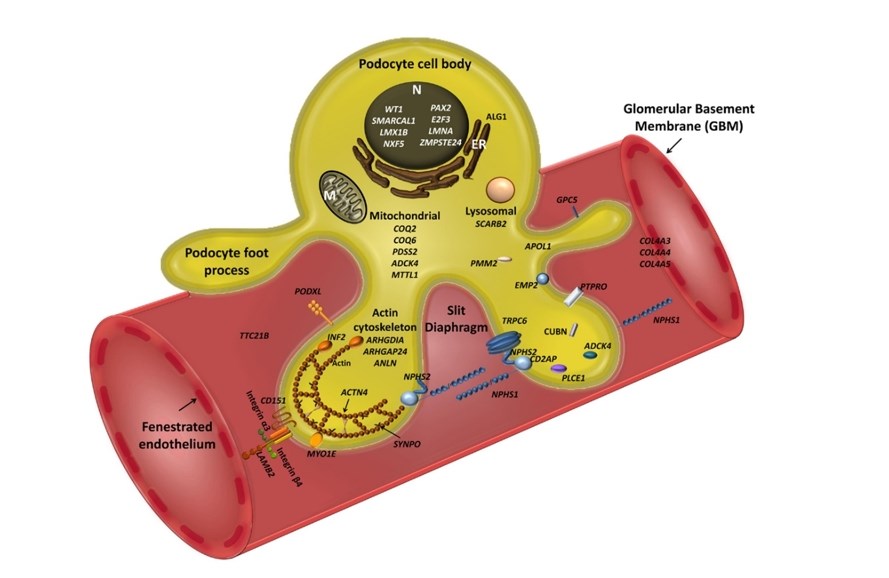What is NPHS1 Protein
NPHS1, or Nephrin, stands as a sentinel within our biological architecture, orchestrating crucial functions within the intricate dance of cellular activities. Officially known as Nephrin (NPHS1), this protein is a vital player in maintaining the integrity of our filtration system. With synonyms like NPHN and NPHN1, Nephrin belongs to the immunoglobulin (Ig) superfamily, a collection of proteins involved in diverse cellular processes. Structurally, Nephrin is characterized by an extracellular region containing eight Ig-like domains, a transmembrane segment, and a cytoplasmic tail, showcasing its structural complexity. Recent research has delved deeper, uncovering nuances in its classification and shedding light on its role in health and disease.
NPHS1 Biological Functions and Molecular Mechanisms
The biological functions of Nephrin extend beyond its structural elegance. Positioned within podocytes, specialized cells within the kidney glomerulus, Nephrin is a linchpin in the filtration barrier. Its presence ensures the prevention of proteinuria, a condition characterized by the abnormal presence of proteins in urine. Functionally, Nephrin engages in intricate molecular interactions, forming a network with other proteins such as podocin and CD2-associated protein (CD2AP). This molecular symphony orchestrates the maintenance of slit diaphragms, small gaps between podocyte foot processes crucial for filtration. The binding of Nephrin to the actin cytoskeleton is pivotal, influencing cell shape and motility. Molecular mechanisms involving nephrin signaling pathways have been the focal point of extensive research, offering insights into how disturbances in these processes contribute to pathological conditions.

Figure 1. Schematic representation of podocyte genes associated with steroid-resistant nephrotic syndrome. (Bierzynska A, et al., 2015)
NPHS1 Related Signaling Pathway
Nephrin's involvement in signal pathways is akin to deciphering a molecular Morse code, where intricate signals relay vital information. Upon ligand binding, Nephrin initiates a cascade of events, activating various intracellular signaling pathways. Src family kinases are recruited, setting off a series of phosphorylation events. The phosphorylation cascade modulates the actin cytoskeleton, ensuring the dynamic rearrangement necessary for podocyte function. Such signaling pathways not only maintain the structural integrity of podocytes but also contribute to the intricate balance between filtration and permeability within the glomerulus.
NPHS1 Related Diseases
The disruption of Nephrin's normal functioning precipitates a cascade of events leading to various diseases. Mutations in the NPHS1 gene give rise to congenital nephrotic syndrome, a severe kidney disorder manifesting early in life. This syndrome is marked by proteinuria, hypoalbuminemia, and edema, underscoring the pivotal role of Nephrin in maintaining the integrity of the filtration barrier. The intricate balance orchestrated by Nephrin in the kidney's glomerulus is delicately tipped when its function is compromised, underscoring the profound impact on renal health.
NPHS1's Applications in Biomedicine
Beyond its role in physiological processes, Nephrin has emerged as a beacon in biomedical applications. Its unique properties make it an attractive candidate for diagnostic development, especially in identifying early signs of kidney disorders. Researchers are exploring the potential of Nephrin in vaccine development, leveraging its immunoglobulin-like domains to stimulate immune responses. The therapeutic landscape is also evolving, with studies exploring how modulation of Nephrin expression or function could serve as a potential intervention in renal diseases. The potential of Nephrin in personalized medicine is being unraveled, holding promise for tailoring treatments based on an individual's genetic makeup.
Recommended Products
| Cat.# | Product name | Species | Source (Host) | Tag |
|---|---|---|---|---|
| NPHS1-5640H | Recombinant Human NPHS1 protein, His & T7-tagged | Human | E.coli | His/T7 |
| NPHS1-29301TH | Recombinant Human NPHS1 | Human | Wheat Germ | N/A |
| NPHS1-689H | Recombinant Human NPHS1 Protein (23-257 aa), His-tagged | Human | E.coli | His |
| NPHS1-6031H | Recombinant Human NPHS1 Protein, GST-tagged | Human | Wheat Germ | GST |
| NPHS1-5044H | Recombinant Human NPHS1 protein, His-tagged | Human | HEK293 | His |
| NPHS1-4726H | Recombinant Human NPHS1 Protein (Pro89-Trp374), N-His tagged | Human | E.coli | N-His |
| NPHS1-3581H | Recombinant Human NPHS1 protein, His-tagged | Human | E.coli | His |
| NPHS1-1843H | Recombinant Human NPHS1 Protein, His&GST-tagged | Human | E.coli | N-His&GST |
| Nphs1-1343M | Recombinant Mouse Nphs1, GST-tagged | Mouse | E.coli | GST |
| Nphs1-6162M | Recombinant Mouse Nphs1 Protein, His (Fc)-Avi-tagged | Mouse | HEK293 | His (Fc)-Avi |
Reference
- Bierzynska A, Soderquest K, Koziell A. Genes and podocytes–new insights into mechanisms of podocytopathy. Frontiers in Endocrinology. 2015, 5: 226.

